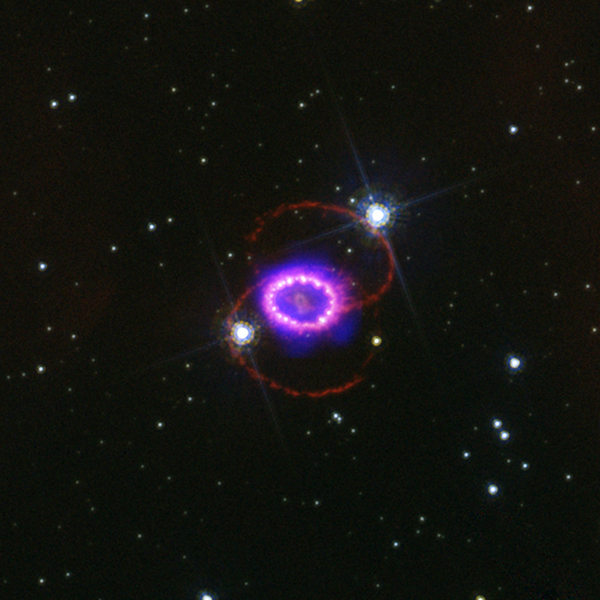
 Credit:X-ray: NASA/CXC/PSU/S.Park & D.Burrows.; Optical: NASA/STScI/CfA/P.Challis
Credit:X-ray: NASA/CXC/PSU/S.Park & D.Burrows.; Optical: NASA/STScI/CfA/P.Challis
Twenty Years in the Making
On February 24th, 1987, Ian Shelton and Oscar Duhalde at the Las Campanas Observatory in Chile, Albert Jones in New Zealand, and Colin Henshaw in Zimbabwe looked at the southern skies and saw something unseen by humans for 400 years - a supernovae so bright and close that it was visible to the naked eye. Named SN 1987a, it provided astronomers with a unique opportunity to study the processes of stellar death in detail with modern instrumentation. A truly watershed event in modern astronomy, the proximity of this exploding star, in the Large Magellanic Cloud (a bit over 160 thousand lightyears away) enabled astronomers to even detect the neutrino outburst which theorists predicted should accompany the explosion, and help power it. The image above is a combination of a Hubble Space Telescope image of the supernovae, along with an X-ray image by the Chandra X-ray Observatory. HST imaging revealed the supernova as a three ring circus: an inner ring produced by the collision of the ejecta from the explosion with the material near the star, while the two outer rings are believed to be light echos produced as the blinding flash lit up two pre-existing structures. Most of the X-ray emission detected by Chandra is produced along the inner ring. Perhaps one day astronomers will find evidence at the center of the ring of a baby black hole.
<
HEA Dictionary ● Archive
● Search HEAPOW
● Other Languages
● HEAPOW on Facebook
● Download all Images
● Education ● HEAD
>
Each week the HEASARC
brings you new, exciting and beautiful images from X-ray and Gamma ray
astronomy. Check back each week and be sure to check out the HEAPOW archive!
Page Author: Dr. Michael F. Corcoran
Last modified Tuesday, 27-Feb-2024 10:15:21 EST


